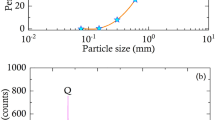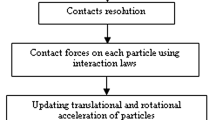Abstract
The discrete element method was widely used in analyzing mechanics and movement behaviors of grain particle in recent years. An application of the method in the field of grains was presented in this paper. The experiment and simulation about the angle of corn indicates that the particle shape cannot be ignored in discrete element simulations, as well as the accuracy particle shape influences the simulation speed indirectly. In order to ensure the accuracy of the calculation results and improve the calculation efficiency, it is important to choose appropriate particle shape and particle material parameters in discrete element simulations.
Access provided by CONRICYT-eBooks. Download conference paper PDF
Similar content being viewed by others
Keywords
These keywords were added by machine and not by the authors. This process is experimental and the keywords may be updated as the learning algorithm improves.
1 Introduction
Grains is one of the granular in the nature. It is slightly insufficient that previous continuum theory in the analysis of the grains processing, storage and transportation. Most researches are based on single particle motion. A great majority of grain particle behaviors were obtained from the experience in production line. With the development of the discrete element technology, the method is widely applied in various fields. At the same time some physical parameters of granular materials need to be obtained. However, in agriculture field most of grain parameters are date from experiments in 1980s. With the development of genetic technology, particles properties of grain were changed as well as gene order. Further more, the grain attribute also has close relationship with regional. In China, particles properties have obvious differences in different regions. Therefore, in order to study the mechanical and motion behaviors of the grain material more accurately, accurate basic parameters are needed.
Grains material is different from other granular, which has special physical properties and characteristics. Grains, whose shape and size are different in a certain range, is non-spherical particle. There are many studies on the non-spherical particles in discrete element method . Ferellec pointed out that the non-spherical particle model accuracy is important [1], Lu and Kruggel-Emden and Rickelt discussed the modeling method of the non-spherical particle [2, 3]. The non-spherical particle consists of multiple sphere in discrete element method, which makes the basic particles unit size smaller. Whereas compared with the equipment size of grain processing and transportation, food material particle size is much smaller. The capacity of the equipment deals with grains particles in tonnage. A huge number of particles take part in calculating and it is a critical and hard issue in discrete element method.
Therefore, this article discussed how to choose grain material parameters and particle model in discrete element method through the experiment of corn angle of repose and simulation, in order to ensure calculation results correctly and improve the computational efficiency .
2 Experimental and Simulation
2.1 Experimental
The angle of repose of grain material is an important basic parameter in transportation and storage. Its value reflects the coefficient of friction between particles. The relation can be expressed as
where f is the coefficient of friction, φ is the angle of repose.
Three standard methods called free-base piling, fixed-base piling and the sliding are applied to measure the angle of repose. We chose the corn whose name is Zhengdan 958 and moisture is 12.3 % as the experiment material and adapt the Fixed-base piling method to get the angle of repose, as shown in Fig. 1. Its value is 31° according to the experiment.
2.2 Simulation
In the simulation, the parameter calibration was focused on the angle of repose of corn. The coefficient of friction was determined in our experiment. Other simulation material parameters were based on available literature. After simulation material parameters determined, establish nonspherical particle by using different number sphere to change the particle model. The multi-sphere particles model and simulation results are presented on Figs. 2, 3, 4, 5 and 6. The calculation results of different combination of spherical particles are summarized in Table 1.
3 Result and Discussion
The simulation and experiment comparison indicate that the combination of spherical particle has effect on simulation results. With the increase of spherical number and the decrease of particle radius, multi-sphere particles are more similar to real particles and simulation results are in good agreement with experimental results, as shown in Figs. 7 and 8. Moreover, as the size of the smallest unit diminishes, simulation is more time-consuming and inefficient, as shown in Fig. 9.
Different particle surface has different contact parameters. The comparison between simulation and experiments of repose angle of corn indicates that particle shape not only influences the simulation results of the angle of repose, but also affects the simulation speed and results indirectly. As particle surface is very sharp,it is composed of a large number of spherical particles (including some small spherical particles) which make particle surface more approximate with the realistic one. So the simulation time increases. But, if less smooth spherical particles combination instead of real particles is used, simulation time will decrease. Meanwhile, the accuracy of the simulation result will be lower. Actually, in the process of grain particle contact, contact area of the grain surface has some influences on the rolling resistance and the coefficient of restitution, which affects the simulation results. To obtain more accurate particle material parameters, choosing the appropriate particle model is necessary. The experimental parameters need to be adjusted to correspond with the particle model, and then they are applied to the simulation calculation.
4 Conclusions
Different particle shape simulation results and the experimental data indicate that the issue not only makes the particle model in the simulation more consistent with the realistic particle shape, but also considers the simulation calculation speed. Comparing with the equipment size, the grain particle size is very small, and the particle number is huge. When the simulation model of particle is close to the actual particle model infinitely, the radius of the minimum combination of spherical particles will be smaller, which makes the simulation speed slow down or even cannot be worked. Therefore, to make it close with the experimental data and achieve a optimal simulation result, it is necessary to balance the relationship between particle model and calculation speed.
When the particle shape is irregular, high precision spherical combination is not good at balancing the computing speed whereas rough spherical combination will have influence on the simulation result. So the parameters and model of the grain material need to do some further adjustment before simulation. Coarse particle surface need smaller friction coefficient. Friction coefficient should be adjustable slightly for smooth or approximate sphere particles.
In addition, the contact parameters obtained from the experiment need to be adjusted in simulation. Every particle model is corresponding to its individual parameters. In order to use discrete element method effectively in the field of grain processing, storage and transport, adjusting proper particle model and parameters according to the experiment and simulation is necessary.
References
Ferellec, J.-F., McDowell, G.R.: A method to model realistic particle shape and inertia in DEM. Granul. Matter 12, 459–467 (2010)
Lu, M., McDowell, G.R.: The importance of modeling ballast particle shape in DEM. Granul. Matter 9(1–2), 71–82 (2007)
Kruggel-Emden, H., Rickelt, S.: A study on the validity of the multi-sphere discrete element method. Powder Technol. 188, 153–165 (2008)
Author information
Authors and Affiliations
Corresponding author
Editor information
Editors and Affiliations
Rights and permissions
Copyright information
© 2017 Springer Science+Business Media Singapore
About this paper
Cite this paper
Sun, H., Zhang, Z. (2017). Discussion on the Difference of the Grain Particle Parameters in Reality and DEM. In: Li, X., Feng, Y., Mustoe, G. (eds) Proceedings of the 7th International Conference on Discrete Element Methods. DEM 2016. Springer Proceedings in Physics, vol 188. Springer, Singapore. https://doi.org/10.1007/978-981-10-1926-5_20
Download citation
DOI: https://doi.org/10.1007/978-981-10-1926-5_20
Published:
Publisher Name: Springer, Singapore
Print ISBN: 978-981-10-1925-8
Online ISBN: 978-981-10-1926-5
eBook Packages: Physics and AstronomyPhysics and Astronomy (R0)













